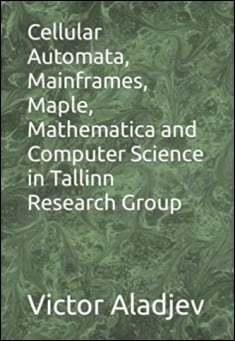This free textbook presents an expanded excursion into the creative activities of the Tallinn Research Group during 1970–2022 with a focus on researches and development in such main fields as mainframes, personal computers, general statistics theory, issues of parallel information processing and computing, computer mathematics systems (Maple, Mathematica), programming, automated control systems, mathematical developmental biology, some mathematical problems in the cellular automata theory with a focus on our standpoint on the main stages of formation of the cellular automata theory. The book may be of certain interest as a retrospective standpoint on development of the above areas in the USSR (primarily in the ESSR) and the republics of the former USSR. The book is equipped with a fairly extensive bibliography on the issues under consideration.
Excerpt:
In the mid–1960s, a number of rather significant problems in the field of computer technology emerged in the USSR. Because of this, there is a need for a quick transition to the mass production of unified computers equipped with a large number of standardized software and peripheral equipment. To solve this problem, it was decided to develop an UCS (Unified Computers System) – a Soviet series of computers, analogues of the System/360 and System/370 series from IBM, produced in the USA since 1964. UCS software and hardware (only at the interface level of the external devices) were compatible with their American prototypes. In the USSR, UCS has been actively exploited since 1971. Meanwhile, in the ESSR (Estonia), the appearance of the first UCS required mass training of specialists (programmers and engineers) for its operation. Moreover, there was an acute shortage of quality literature for the users. Therefore, along with mastering the UCS, in a number of organizations in Tallinn we organized appropriate courses for the users, prepared and published appropriate manuals, which received positive responses in the USSR as a whole [6,7]. This approach made it possible, within a fairly reasonable time to introduce UCS in a number of leading organizations of the ESSR, in particular, the Central Statistical Office of the ESSR.
Given the prospects for the development of UCS models, we decided to focus on the operating system of the OS (analog of OS/360), instead of the DOS disk operating system (analog of DOS/360), that was delivered with junior UCS models with limited hardware resources. Therefore, in order to ensure the possibility of using UCS with OS to program the problems of automated control systems (ACS), in particular, ACS of trade by us in 1976, the MINIOS operating system was created – an optimized version of OS IBM/360 for junior UCS models [8]. MINIOS was at one time quite widespread in Estonia, Russia and Ukraine in the development of ACS for various purposes in various institutes and enterprises.
The Database Management System (DBMS) is a certain set of software and language tools that allow to create databases (DB) and manage data.
DBMS play an important enough role in information processing software systems, in particular in various types of ACS. As a DBMS, the DBMS OKA (an analogue of the IMS DBMS of IBM) was determined during the development of the Collective Use Computing Center (CUCC) of the CSO of the ESSR. Meanwhile, created as a new technology for the IBM System/360 platform, the system for its effective functioning required more powerful UCS models than available at that time in ESSR. In this regard, the DBMS was created on the basis of the MINIOS operating system and the OKA DBMS (optimized version of the IMS DBMS), that have been developed by the author during his stay in the Estonian branch of VGPTI CSO USSR [9]. The created systems allowed them to be used on UCS with minimal hardware resources, allowing you to significantly expand the applicability of these systems at that time and allowed you to significantly speed up the programming and debugging of software for the CUCC users and ACS tasks. In order to expand the programming capabilities on computers of the second and even third generation, we have proposed the method of so–called "disk transits" which allowed us to program a number of problems more efficiently [10,113].
In the CSO system of the USSR, in the tenth five–year plan, the first stages were to service information and computational work not only of statistical bodies, but also of enterprises and organizations of various departmental of four CUCCs were created in Minsk, Tallinn, Tula and Tomsk, the tasks of which provide modes of time sharing, teleprocessing and dialogue with computers, ensuring the functioning of territorial ACS. It was at all the main stages of the 1st stage of CUCC creation in Tallinn that the TRG took a rather active part, which was repeatedly noted in the systems of both the CSO of the ESSR and the CSO of the USSR. Note, members of our group took a rather active part both in the creation of the CUCC itself, and in setting and programming the tasks of the ACS of a number of enterprises-users of the CUCC, in particular, the ACS Trade of the ESSR. TRG also took a certain part in the design of the republican ACS of the ESSR along with automated system of state statistics.
As part of the design and creation of the CUCC of CSO of the ESSR and a number of other CUCC in the USSR, we carried out both theoretical and practical developments on parallel information processing systems on computer networks. In particular, the collections [10,11] contain our works on parallel information processing systems, parallel algorithms, their modeling in homogeneous structures, which are the theoretical basis of parallel computing. In particular, one of the purely applied tasks of paralleling was the introduction of parallel processing technology for accounting tasks [8] as well as some other tasks of users of the CUCC of CSO of the ESSR, components of automated control systems.









